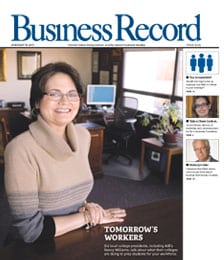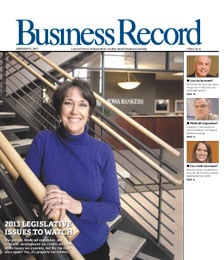Companies compare benefits to maintain competitive edge

In the past four months, GeoLearning Inc. has added more than 30 employees, as it continues to grow at a sprinter’s pace that has tripled the West Des Moines Web-based training company’s workforce to 140 in just two years.
Because of that growth, “it’s really important for us to remain competitive in benefits,” said Robin Salsberry, GeoLearning’s human resources director. Last fall, the company measured its benefits package against those of other Iowa employers, using a benchmarking program designed by David P. Lind & Associates, a Clive-based benefits broker and consulting firm.
“We were really happy to see we were right on target with the benefits and the competitive environment that we maintain,” Salsberry said, “especially for as fast as we’ve grown.”
The Lind firm, which first surveyed employers in nine Central Iowa counties in 1999, has since broadened its annual survey into a statewide effort that compiles data from more than 600 Iowa companies that employ 20 or more people.
“We realized there was a huge void in this type of data among Iowa firms,” said David P. Lind, whose company uses Data Point Research Inc. of Ames to conduct the statistically valid survey. Of the 1,480 Iowa businesses randomly selected to participate in the 2004 survey, 42 percent responded.
According to the 2004 survey, average health premium costs rose 15.7 percent over 2003. The majority of employers, 69 percent, said they shared those additional costs with employees, while 17 percent said they absorbed the entire increase and 4.5 percent said they passed the entire increase on to employees. Twenty-nine percent said they reduced benefits to minimize or eliminate a premium increase.
That mix may explain why employee contributions to health premiums for single coverage have increased just 36 percent during the past five years, even though premiums have jumped 65 percent since 2000.
“The employee may view plan changes or reductions in benefits as a takeaway, but (employers view it as) the lesser of two evils,” Lind said. “They don’t want to take away from the employees’ take-home pay.”
That may also explain why deductibles for preferred provider organizations, the type of plan used by the majority of Iowa employers, have more than doubled in the past five years. The average out-of-pocket expense for single coverage has gone from $280 in 2000 to $572; the family coverage deductible has gone from $599 to $1,204 in the same period.
As with most Central Iowa employers, managing costs while staying competitive is a balancing act for Orchard Place. The child and youth services organization, which employs more than 250 people, has used Lind’s benchmarking process for several years.
“As a non-profit organization, we have a lot of budget concerns obviously, but it’s important for us to be able to offer competitive benefits to attract good employees,” said Val Saltsgaver, its chief financial officer. The organization compares its benefits not only to those provided by other non-profits but also to those of for-profit organizations in the 250-plus employee range.
“We use it as a tool for our budgeting, and it’s quite helpful,” Saltsgaver said. “We can’t always meet all of the competitive averages out there, but it’s our goal to get closer to them.”
Like many employers, Orchard Place’s total premium costs increased by about 16 percent last year. Sometimes the organization has picked up more of the cost; in other cases the employees have, but it seems to balance out, she said.
“It’s always been our philosophy that neither the employee or the employer should have to shoulder the entire burden,” she said.
Employers have to do a better job of communicating their efforts to manage health-care costs to their employees, Lind said. “They may do a good job in their benefits program, but they’re not tooting their own horn,” he said. In some cases, clients have asked his firm to present the results of the survey to achieve better buy-in from employees on the reasons behind their decisions.
Other companies, among them GeoLearning, have used the benefits comparison to help them shop for another health insurance provider.
“With the cost increase,” Salsberry said, “it forced us to go out there and see what kind of other plans are out there but still have very comparable benefits.” The company switched last year from Wellmark Blue Cross and Blue Shield to UnitedHealthcare.
“It was great,” she said. “It allows you to make sound decisions on an annual basis. And we’re coming up for renewal pretty quick.”
Web-based yardstick available
Central Iowa employers can now compare their benefits programs with those of businesses throughout the state, using a Web-based program created by two Greater Des Moines companies.
Adapting a proprietary program originally developed for its clients, David P. Lind & Associates of Clive recently launched the benchmarking program, using an interactive Web site designed by Spindustry Systems Inc.
“We’re excited about it because it’s really a first-of-a-kind,” said David Lind, a benefits broker who started the benefits broker and consulting firm in 1995. “Due to the great amount of interest employers had in comparing their benefits with our study, we hired Spindustry to write a Web application that will allow non-clients to benchmark their own plans over the Internet.” The service, which costs $275, can save employers considerable time in comparing benefits, he said.
The program, which can be accessed at www.dplabenchmark.com, also provides survey results showing the prevalence of 24 types of benefits, such as health and dental coverage, life and disability plans and paid time off, within 10 industries.







